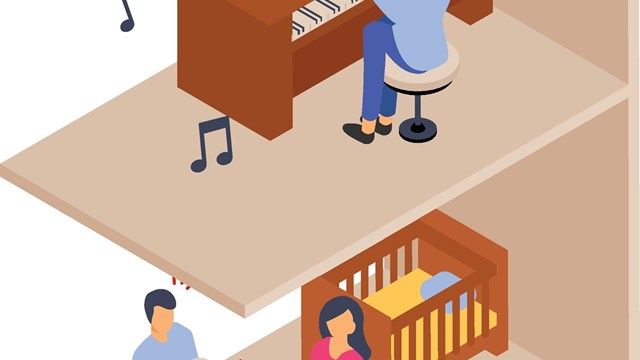
During a recent news conference about noise pollution, Michael Horodniceanu—the Metropolitan Transportation Authority’s president of capital construction—had to shout in order to be heard while speaking at a Second Avenue construction project. “If you really want quiet,” he bellowed, “go to the country.”
That statement says it all…oh the joys of living in New York City. Without a doubt, if the city’s president of capital construction admits that a quiet lifestyle doesn’t exist here, perhaps it is truly pointless to throw time and money to soundproofing…even the most advanced techniques won’t silence that wrecking ball demolishing the condemned building across the street.
Alas, noise pollution is a significant problem for almost anyone living in a densely populated environment. As studies—and basic common sense—suggest, few metropolitan areas have bigger issues with noise than the Big Apple; it is one of the most common complaints boards and managers receive. Though, over the years, many engineers, architects, and designers have developed ways to reduce excessive noise in multifamily buildings. Some have had more success than others.
According to A Guide to New York City’s Noise Code: Understanding the Most Common Sources of Noise in the City—as documented by the city’s Department of Environmental Protection (DEP)—people complain about disturbing noises coming from these most common violators: construction, animals, vending machines, air conditioners and other circulation devices, garbage trucks and other motor vehicles, neighbors, and music from bars, restaurants, and nightclubs.
A recent New Yorker magazine article found that that top ten noise complaints from 311 calls centered around loud parties, construction noise, barking dogs, cars, air conditioning or ventilation equipment. Loud music or parties accounted for 52,369 complaints (37 percent); construction noise, 23,180 (16 percent); loud talking, 18,210 (13 percent); car/truck music, 8,962 (6 percent); barking dog, 7,480 (5 percent); construction equipment, 5,819 (4 percent); air conditioning/ventilation equipment, 4,200 (3 percent); car engine-idling, 3,886 (3 percent); car/truck horns, 3,374 (2 percent); banging or pounding noises, 3,087 (2 percent) and other, 10,098 (7 percent).
“When a person hears something, they have a reaction called ‘the human response to noise,’” says Mason Wyatt, owner of City Soundproofing, a firm based in Manhattan. “For example, when you are inside a restaurant having dinner, and suddenly you hear an obnoxious laugh, you will hear that specific noise the entire time you are there, as long as those people are there with you,” he says.
Wyatt continues with his explanation of what the brain experiences after noticing an unpleasant noise. “Your mind subconsciously picks out that sound and focuses on it,” he says. “You hear that noise a lot easier after it catches your attention for the first time…that’s the moment when the noise starts to bother you; it becomes more noticeable from that second forward.”
In New York City, many residents have these kinds of problems because noise pollution easily penetrates the barriers of their co-ops and condos as construction laws pertaining to soundproofing were not established during the time period in which the building was built; similar complaints stem from buildings that are newer, but simply fail to comply with soundproofing regulations set forth by the city.
“Frequently, floors and walls are merely paper thin or, sometimes, they are made with wood; neither insolate or block out distracting noises very well,” says Eugene Ferrara, president of JMA Consultants & Engineers, P.C., based in Englewood Cliffs, New Jersey. “Many new co-ops or condos are not wooden-frame buildings and don’t have this issue; though, even in new buildings, often you have walls made of sheetrock. This is problematic, as well, as this type of wall isn’t properly insulated.”
According to its official website, the New York City Noise Code was created to reduce “the making, creation, or maintenance of excessive, unreasonable, and prohibited noises within the city that is a menace to public health, comfort, convenience, safety, welfare and prosperity of the people.”
As residents might expect, the vast majority of local governments in densely-populated cities limit neighborhood sound levels and noise production with restrictions and ordinances. New York, of course, has such regulations. Many case studies conclude, however, that noise codes are not particularly effective…a concept clearly demonstrated by the number of complaints made by residents.
For instance, according to Baruch College’s Survey Research Unit at the School of Public Affairs, New Yorkers are “much more likely” to complain about noise than respondents in other cities in the United States. When comparing New York to other cities, the survey determines nearly twice as many New Yorkers complained to their neighbors about noise; six times as many New Yorkers complained to a government helpline (such as 311); and the police were contacted by more than twice as many New Yorkers about noise concerns.
New York City’s Noise Code has a penalty chart…a very complicated one. For the sake of simplicity, here’s one example. Typically, a first-offense penalty for noise or sound coming from a personal device (exceeding permitted levels…measured in decibels) is $250; the second is $500; the third is $700; and the fourth is $1,000. Though, there are different penalties for different violations…and some are rather intriguing (using a cell phone during a public performance warrants a $50 fine).
“People complain that their neighbors are not supposed to make so much noise and, of course, they are not,” says Wyatt. “On a good day, the city claims that 50 decibels of noise is too much and considered a violation. In an attempt to stop the noise, the resident must send out a letter. Then, they hire a professional to measure the noise levels, all while they are occurring, in order to prove the noise warrants a violation. This process can cost a great deal of money, possibly up to $3,000.”
Wyatt continues, claiming it is far easier (and less expensive) to hire a soundproofing professional to rectify the current and future noise pollution issues. “After sending a letter, if you are not ignored by the city, you may have a case,” he says. “Then, you must hire a lawyer, and that will cost thousands upon thousands. The whole process will take approximately eight months, and cost so much. It’s far cheaper and faster to hire a soundproofing company to permanently stop this kind of problem. I don’t spend time or money on measuring the noise pollution levels like the city does before they take action. I just know where the sound is coming from…and how to stop it.”
Although soundproofing technology has continued to evolve over the years, many professionals believe firmly more in the techniques that have existed for decades. One popular method of soundproofing that is frequently used is one of several insulation techniques, including the installation of a lightweight fiberglass that controls noise pollution when placed in interior partitions; additionally, there are vibration insulation pads, which protect condos and co-ops from the precise foundation of noise…vibrations.
Sound isolation strips—which are installed onto ceiling joists or in walls—are quite popular among soundproofers, as well. “Isolation strips help to reduce loud noises by preventing their transfer through a specific barrier,” says Wyatt. “This is, of course, is a major component of sound transmission…thus, these strips are effective in reducing noise pollution.”
Furthermore, a substance called Green Glue has a unique way of improving noise conditions in condos and co-ops. It is a damping compound, meaning the compound dampens (or lessens) the effect of vibrations, and diminishes obnoxious and loud noises. It is applied onto construction materials, somewhat like drywall. “Green Glue is relatively new, though it has been around for a little while,” says Wyatt. “Placed between a material and the drywall, it is part of a system that prevents vibration between the layers. Without vibrations, sound has a very hard time existing at all.”
Also highly recommended is a simple but innovative product called spray foam insulation. It’s a liquid substance that is sprayed from a can; it hardens after filling an empty space and helps to prevent unwanted noise from entering (or exiting) a room.
While one can acknowledge New York City does at least attempt to regulate noise pollution with regulations and ordinances, city officials have a long ways to go before adopting regulations that protect residents completely.
“Recently, we have started to see building requirements call for foam backing under the wood flooring, which requires sheetrocking to be placed around open joints in the walls,” says Ferrara. “At JMA Consultants and Engineers, we always review renovations…and we’ve been insisting on these items for close to 10 years now. But at least these construction requirements are improving.”
Clearly, hiring a soundproofer to manage noise pollution seems like a task far easier, cheaper, and faster than filing a formal noise complaint to city officials. Though, if option two seems like a better choice, New Yorkers can reach those city officials through the citizen service hotline via 311. Residents can also submit a complaint online as well by going to nyc.gov/311.
Speaking of 311—here’s another statistic. During the service’s first two years of operation, out of 18 million calls, over 620,000 were noise-related. That’s a number those city officials should be hearing…loud and clear.
Wesley Strickland is a freelance writer and a frequent contributor to The Cooperator.






Leave a Comment